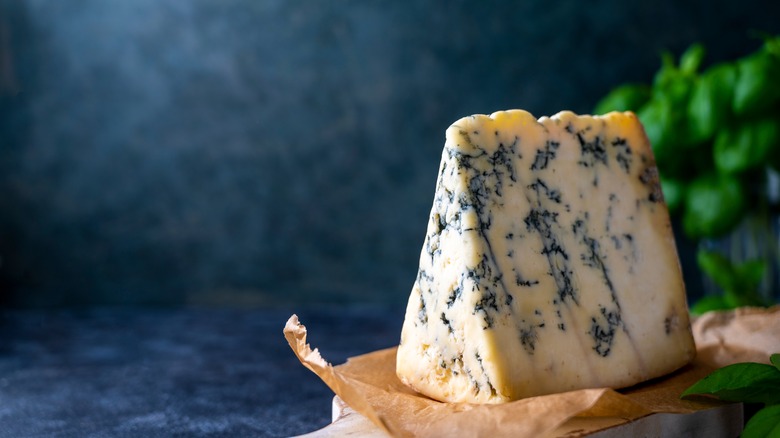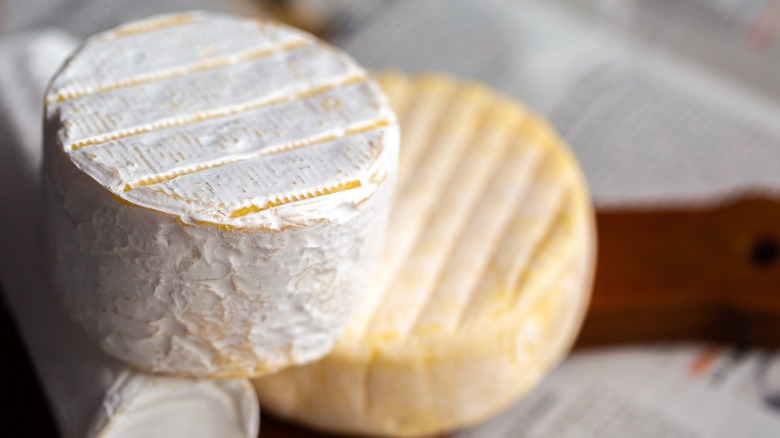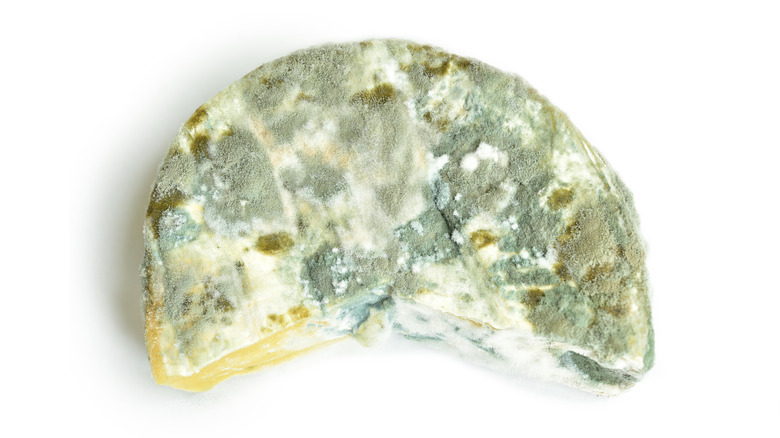How To Tell Bad Mold From Good Mold On Soft Cheeses
Usually when you look in the refrigerator and see something covered in blue-green spots or pale fuzz, you toss it straight into the compost. But there's one type of food that breaks the mold (pun absolutely intended). Many types of cheese, especially some soft cheeses, are supposed to have a certain degree of mold, making it far more challenging to discern the good from the bad. As you read the title of this article, you probably thought of blue cheese, a fragrant delight that's essential to any cheese plate, as well as the greatest salad ever conceived: the iceberg wedge. But the role of mold in cheesemaking runs far deeper than the blue veins in your Stilton.
Many of the world's most popular cheeses would not exist without mold. Take brie, for instance. Its flavor and aroma are much milder than blue cheese, but mold plays a key role in making it. Bon Appétit points out that the white rind encasing each wheel of brie consists of a mold called Penicillium candidum. If it weren't for that layer of mold, brie would be quite unpleasant. Per The Guardian, brie begins its life as a wheel of curds with a chalky texture, and it takes the introduction of mold to break those curds down into the creamy treat we love. Mold deserves more respect than we give it, but not every type of mold is welcome on our cheese, so we need to distinguish the good from the bad.
Not all molds are created equal
Before we go further, we should clarify what mold actually is. Per Healthline, molds are types of fungus that proliferate via spores, which spread throughout the environment via air, water, and insects. While it may sound disgusting, mold can be found just about everywhere in our world, especially where it's warm and moist. This last fact is key, as Bon Appétit notes that microorganisms are less active in dry environments, explaining why mold is more prevalent in soft cheeses than hard varieties like Asiago and Parmesan. Mold spores play a vital role in developing the flavor and texture of soft cheeses by eating the proteins and sugars that are naturally present in milk, causing chemical transformations.
Cheesemakers intentionally introduce mold to their product, either internally or externally. According to The Cheese Life, the internal mold you see in blue cheese is made by piercing the cheese with stainless steel rods to force mold deep into the interior. External molds, which form the rinds of many cheeses, can be introduced in several ways. The aforementioned brie is a "bloomy rind" cheese, one of many that are made by coating the exterior with Penicillium candidum during the aging process. There are also "washed-rind" cheeses, which are typically made by rubbing a bacterial solution on the cheese but may also be made by submerging the cheese in a brine where certain microorganisms thrive. Cheesemakers carefully monitor their product to ensure the right mold grows where it should.
How to identify bad mold
While certain molds are welcome in cheese, others are most certainly not. The good news is that on hard cheeses, few types of mold are likely to pose a legitimate threat to your health. Bon Appétit warns against touching anything with black mold, but it's rare that you'll ever find that growing on cheese. However, mold will certainly mess with the flavor, and can be dangerous in soft cheeses as it can carry harmful bacteria (per Healthline). Fortunately, discerning the good mold from the bad mold is quite easy to do. Healthline recommends establishing a baseline immediately after you purchase cheese so you know what it should look and smell like. If you notice mold or funky smells that weren't there when you bought the cheese, it means spoilage is beginning to occur. Mental Floss notes that bad mold will appear pink, yellow, or fuzzy. A slimy texture is also indicative of spoilage.
If you do notice unwelcome mold on your cheese, you don't necessarily need to throw it away. Bon Appétit explains that mold takes a while to penetrate cheese, especially firmer varieties, so you can usually just cut off the moldy exterior bits and eat what remains. However, with very soft cheeses, mold can invade much quicker, so you'll probably want to send those to the compost. Healthline lists ricotta, cream cheese, and cottage cheese as types that should be pitched if any mold appears on them.


